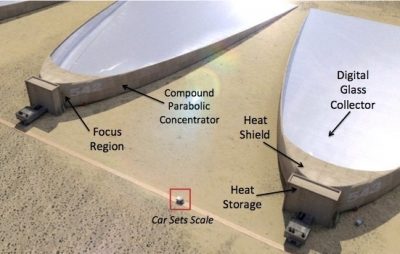Giant Leap Technologies Receives Cooperative Award from DOE

Giant Leap Technologies (GLT) has received a two-year, $2.2 million cooperative award from the U.S. Department of Energy SunShot Initiative. With support from Lawrence Livermore National Laboratory (LLNL) Center for Engineered Materials and Manufacturing, the company will develop capillary optics to replace expensive and wear-prone mechanical sun trackers with low-cost invisibility-inducing digital-glass for solar thermal and photovoltaic applications – i.e. base-load and peak-load needs.
Solar energy collection technology represents one of the biggest opportunities to reduce the cost of solar energy because traditional mechanical solar collectors, like heliostats, require large amounts of steel, concrete, and land area. Digital Glass has to the potential to replace today's sun tracker stations, sometimes weighting tons each, with thin transparent panels using a fraction of today's materials, while also drastically reducing the area needed for solar power plants by a factor of 5 to 10 for the same annual energy harvest. This is because Digital Glass is area-filling and it is not deployed to allow sunlight to fall between trackers–unlike today's collectors. These features will allow GLT to overcome the high-cost of today's solar collectors while further lowering the environmental impact of solar energy.
Giant Leap Technologies has already demonstrated an early-stage and physically large prototype. The SunShot award will allow GLT and LLNL to refine the design and reduce the size of the technology to roughly the thickness of a car's windshield, which is practical and low-cost. The team will advance new techniques in 3D-printing of opto-microfluidic structures having micron feature sizes with a manufacturing technique that can eventually scale to square meter areas. This is an increase in fabrication volume of nearly one billion times what was typical a few years ago.
"At Giant Leap Technologies we believe that the next major advance in solar energy lies in liberating nature's secrets for the electronic control of sunlight. It will provide amazing and previously unimagined ways to deploy low-cost solar power installations and has the potential to set new directions for both the solar thermal and photovoltaic industries for decades to come," said GLT's CEO and former NASA Jet Propulsion Laboratory engineer, Leo DiDomenico.





